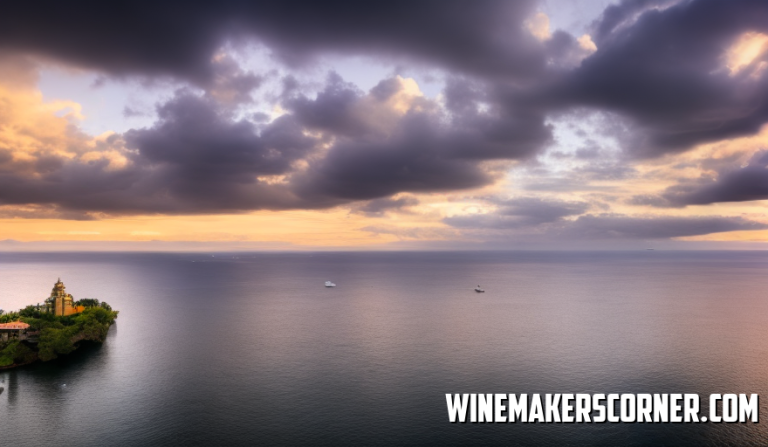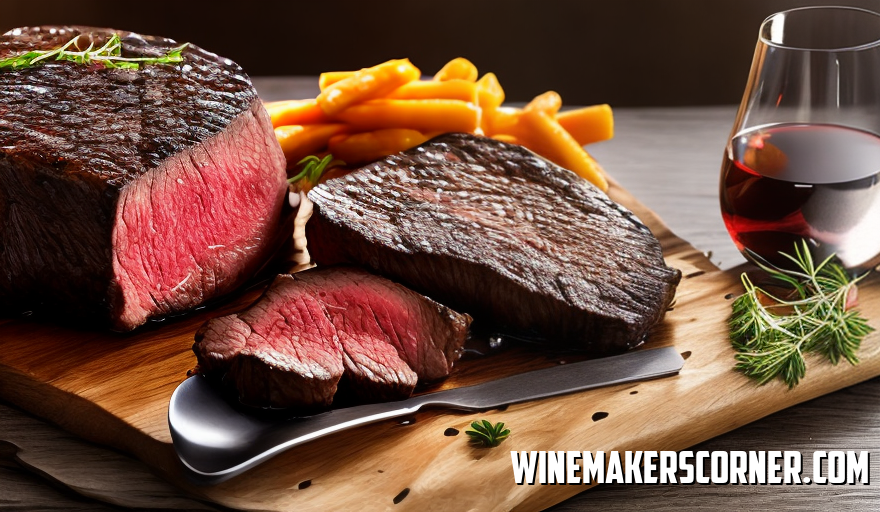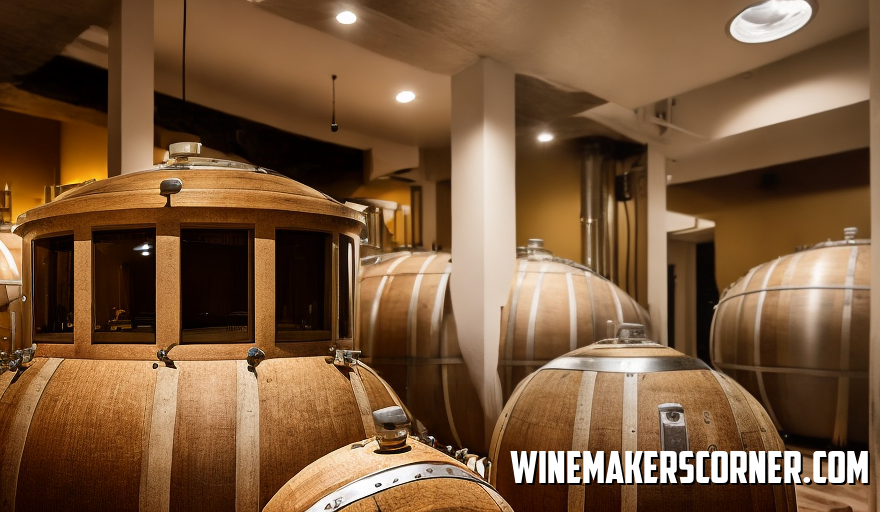Step into the realm of wine enthusiasts, where the hue, scent, flavor and transparency of your white wine provide valuable insights into its journey from vineyard to glass.. Have you ever come across a bottle of your beloved Chardonnay or Sauvignon Blanc that has lost its crystal clear allure? Suddenly it appears murky, hazy… Cloudy. What caused this change? Was it some spirit playing tricks on your bottle when you weren’t looking?. Is there a more scientific explanation for this mysterious phenomenon in wine?
This article will take you on an exploration to uncover the reasons behind the swirling tempest within a wine bottle. We will delve into temperature fluctuations. The impact of oxidation dance with particles of sediment and tartrate crystals and ultimately discover how to prevent cloudiness from tarnishing your white wine experience.. For those concerned about the safety or taste of their cloudy libation. Fear not! We have answers for you well.
Hold on tight! The world of wines is much more, than just sipping and relishing; it is an exhilarating adventure filled with unexpected twists and turns. Let us venture into the heart of this perplexing cloudiness together!
Understanding the Nature of White Wine
The world of wine is vast and diverse with each bottle carrying its own unique story. However there are times when this story takes a twist. Your clear golden liquid has now turned cloudy! What could have caused this? Lets explore this occurrence.
First and foremost there’s no need to panic. Cloudiness in wine doesn’t always indicate spoilage. Often it is simply a result of the winemaking process or changes in temperature.
Winemaking involves stages. From harvesting and pressing to fermentation and aging. Throughout these stages tiny particles such as yeast cells or grape solids can remain suspended within the wine. Usually these particles are filtered out before the wine is bottled; however in some cases, with handmade wines that undergo minimal filtration they may still be present.
Now lets discuss temperature fluctuations. If your wine has been exposed to heat or cold it can also become cloudy. This phenomenon is known as ‘cold stabilization’. When wines become cold natural components found in grapes called tartrate crystals can form and create haziness in the wine.
Cloudy white wine may not be visually appealing. It doesn’t necessarily mean that the wine has gone bad or spoiled. In fact many winemakers intentionally leave their wines unfiltered to preserve flavor and aroma compounds.
However if you happen to detect an odor or taste accompanied by cloudiness – such as a vinegar like aroma or flavors reminiscent of mold – then it’s possible that your white wine has spoiled due to inadequate storage conditions or cork contamination.
To summarize; The presence of cloudiness in wines alone should not be a cause for concern. It is often a phenomenon that reflects genuine winemaking techniques or fluctuations, in temperature during storage.
Causes of Cloudiness in White Wine
Cloudiness in wine can sometimes cause concern. It’s a common occurrence but often misunderstood. There are reasons why this happens.
Firstly lets talk about temperature changes. When there are fluctuations in temperature it can cause the proteins in the wine to clump together resulting in cloudiness. This is more likely to happen if the wine has been stored or transported improperly.
Another factor is the involvement of yeast. During fermentation yeast is responsible for turning grape juice into wine. However if some yeast doesn’t fully settle after fermentation it can contribute to cloudiness.
Unfiltered wines also play a role. Some winemakers choose not to filter their wines for reasons related to taste and texture. While this decision may enhance flavor profiles it can lead to an appearance.
Lastly there are what we call “tartrate crystals” or “wine diamonds.” These harmless crystals form when tartaric acid combines with potassium under conditions. They occur naturally. Can make your wine look cloudy.
In conclusion if you notice cloudiness in your wine it doesn’t necessarily mean that the wine has gone bad. It could be due to temperature fluctuations remnants of yeast activity unfiltered winemaking methods or the formation of tartrate crystals. However if you’re uncertain, about the quality of your wine – always rely on your senses of smell and taste before taking that sip.
Effect of Temperature on White Wine
Temperature plays a role in both the visual appeal and flavor of white wine. When properly handled it exhibits a clear golden color. However mishandling can lead to cloudiness, which’s n’t just an aesthetic concern but also significantly impacts the taste.
To understand why temperature affects wine we need to consider its composition. Wine comprises components such as tannins, acids and alcohol each of which reacts differently to heat and cold. When the temperature is either too high or too low these compounds may undergo reactions.
Excessive heat poses a threat to white wines. Elevated temperatures accelerate oxidation resulting in an appearance. This isn’t about looks; oxidation also dulls or flattens the wines flavor profile.
Conversely cold temperatures can prompt the formation of tartrate crystals in your bottle of white wine. These crystals are substances found in grapes that solidify when exposed to prolonged low temperatures. While harmless they can cause haziness or sedimentation, in the wines appearance.
So whats considered optimal?Most white wines tend to thrive when stored at temperatures ranging between 45 55°F (7 12°C). If the temperature falls below this range it may lead to the formation of tartrates while warmer temperatures can accelerate oxidation.
It’s worth noting that cloudy appearances in wines don’t always signify a problem! Some winemakers intentionally choose not to filter or fine their wines as it adds complexity and texture to the wine resulting in a hazy product.
To sum up it is crucial to maintain storage conditions, for your white wines. This not helps preserve their visual appeal but also ensures that their taste profiles remain intact.
The Role of Oxidation
Oxidation, a process in the making of wine can also pose a significant threat to its quality. It plays a role in determining how your white wine looks.
During the winemaking process oxidation is beneficial as it enhances flavors and aromas. However once the bottle is sealed and stored on your shelf excessive exposure to oxygen can cause spoilage.
Now picture this; You’ve opened a bottle of your white wine. Of the usual clear liquid you expect you’re greeted with a cloudy substance. What went wrong? Oxidation could be to blame.
When white wine comes into contact with oxygen it can transform from its state into a cloudy mixture. This occurs due to chemical reactions triggered by oxygen interacting with compounds in the wine. These reactions create particles that scatter light differently than before resulting in cloudiness.
But it’s not just, about appearance; oxidation also affects taste! A small amount of exposure may introduce nutty or caramel notes into your wine—flavors that some palates appreciate. However over time the taste becomes flat and unappealing as those vibrant fruity notes fade away.
So what’s the solution? Proper storage is essential!Make sure to keep the bottles upright during the days after opening to minimize any contact, between oxygen and the surface of the wine. Once those few days have passed it’s best to store the bottles so that the corks stay moist and create a tight seal preventing air from getting inside.
It’s important to remember that oxidation plays both an challenging role in winemaking. Having an understanding of its significance allows us to savor each sip more even if our beloved white wine happens to turn cloudy.
Impact of Sediments and Tartrates
Sediments found in wine are completely natural and can be a result of the aging process or winemaking techniques. With time aged wines tend to develop sediments as tannins and pigments bind together. On the hand unfiltered wines may contain residual yeast or other particles that remain after fermentation.
These sediments pose no harm; in fact they signify a wine that has undergone minimal processing. However they can cause the white wine to appear cloudy because these tiny particles are suspended within the liquid obstructing passage of light.
Now lets discuss tartrates. Those crystal like substances sometimes discovered at the bottom of a bottle or on the cork. Tartrates are crystals made of potassium bitartrate that form when tartaric acid (an acid found in grapes) combines with potassium under specific temperature conditions.
Tartrates can also contribute to cloudiness in wine. This cloudiness occurs when these crystals remain suspended within the wine than settling entirely at the bottom of the bottle. Like sediments tartrates are harmless. Have no impact, on the taste or quality of your wine.
Enough some winemakers intentionally retain tartrates in their wines as part of their winemaking philosophy to create a more natural product.
You may find that some people opt to eliminate these particles using a technique known as stabilization, which helps maintain a visually clear appearance of the wine.
Just keep in mind if you happen to notice any sediment or cloudiness caused by tartrates in your wine there’s no need to worry! These natural occurrences are often seen as signs of craftsmanship rather, than indicators of inferior quality.
How to Prevent Your White Wine from Turning Cloudy
Cloudy white wine can be a bit worrisome causing concern among wine enthusiasts and connoisseurs alike.. Fret not! There are ways to avoid this issue.
First and foremost temperature plays a role. It’s essential to store wine at a consistently cool temperature, preferably between 45 55 degrees Fahrenheit. Fluctuations in temperature can lead to the formation of sediment in the bottle resulting in cloudiness.
Next consider how you store your bottles. Do you keep them upright or on their sides? For long term storage it’s best to lay them on their sides. This maintains the corks moisture levels. Prevents air from entering the bottle, which could cause oxidation and cloudiness.
Proper transportation is often. Equally important. Avoid shaking or jostling that can disturb sediments and create a cloudy appearance. Always handle your wine with care.
Lastly bear in mind that some cloudiness is natural and doesn’t necessarily indicate an issue, with your wine! Unfiltered wines or those aged for periods tend to have sediment at the bottom of the bottle, which may result in cloudiness when poured.
To sum it up maintaining storage conditions and handling your white wines delicately can help prevent them from turning cloudy.
Don’t worry if you notice some haziness as it could simply be a normal aspect of getting older.
The Safety and Taste Implications of Cloudy Wine
Cloudy white wine can be quite surprising. It’s not what we typically expect when we pour ourselves a glass of our Chardonnay or Sauvignon Blanc.. Don’t worry. In cases the cloudiness doesn’t indicate spoiled wine.
There are reasons why white wines can become cloudy. One common reason is stabilization, a process in winemaking that prevents the formation of tartaric acid crystals after bottling. These crystals resemble shards of glass and are harmless but undesirable in the final product.
Sometimes the cloudiness may be due to proteins that haven’t been filtered out during the winemaking process. Times it could be caused by yeast or bacteria activity, which might also impact the taste. If your wine has a smell or tastes sour it’s best to discard it.
Now lets discuss natural wines. Wines made with technological intervention. They often exhibit cloudiness because they are unfiltered and unfined intentionally leaving in all those yeasts and sediment in the bottle. This can lead to an intricate flavor profile.
Cloudy wine is not necessarily bad or unsafe to consume. In fact some enthusiasts actually prefer their whites with a haze, for an added burst of flavor and character!
However if you notice any odors or tastes accompanied by cloudiness – like the scent of moldy fruit or a wet dog – it could be an indication of spoilage.
To put it simply; there’s no need to worry when you come across white wine! It’s often an occurrence, during the winemaking process or a deliberate choice made by the winemaker.
Remedies for a Cloudy White Wine
White wines are adored not for their vibrant appearance but also for their delicate flavors. However it can be quite disconcerting for wine enthusiasts, new ones, when their beloved Chardonnay, Sauvignon Blanc or Riesling becomes cloudy.. Fret not! Cloudiness, in wine is actually quite common and there are several ways to address it.
It’s important to note that cloudy wine doesn’t necessarily mean it’s bad. It could simply be unfiltered. Have undergone a secondary fermentation process, which often adds a more intricate flavor profile.. If you prefer your white wines crystal clear here’s what you can do.
One option is to decant the wine. Pour it into a decanter or another bottle while leaving behind any sediment that may be causing the cloudiness. Just be cautious not to agitate the wine during this procedure.
Another method involves the use of egg whites – yes you heard that right! Egg whites have long been utilized in winemaking as a means of clarifying wines by binding with particles that cause haziness. Simply whisk an egg until frothy and then gently add it to the wine while stirring. After a hours these particles will settle down and your wine will regain its clarity.
Alternatively you may want to consider chilling the wine for a hours before serving as another approach to potentially enhance its clarity.
Cloudiness in wine is often caused by proteins that have not fully settled in the liquid. One way to expedite this process is by chilling the wine.
To sum up although cloudy white wine may appear unappealing at first it does not necessarily indicate any issues with your chosen beverage. With these suggestions, in mind you can effortlessly restore clarity. Savor your preferred white wines as you did before.



